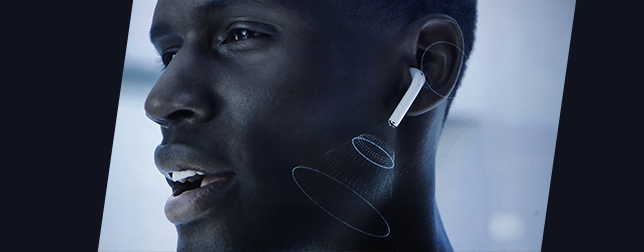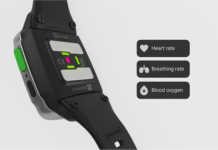Apple’s unexpected entry into the hearables market heralds a period of major change. The result is likely to be a faster move to wireless headphones, an acceleration in the take-up of earbuds, and the prospect of an overall market revenue exceeding $40 billion in 2020.
On September 7th 2016, Apple made three announcements that look set to alter the course of the hearables market. One had been predicted – the removal of the 3.5mm audio jack from the iPhone 7. It was a change that they described as courageous, but which many decried as retrograde. However, it fundamentally changed the dynamics of the market for wireless headphones.
The second two announcements were much bigger surprises. Apple had designed its own wireless chip, and they were entering the hearables world by launching their own brand of earbuds, known as Airpods. Both were unexpected moves. The pistol starting the hearables race had already been fired, but now it became obvious that the race was serious.
Life before Airpods
The hearables market goes back to the first Bluetooth headsets which were launched in 2001, followed by wireless stereo headphones, which arrived a few years later. Neither made great waves in the market – headsets were associated with cabbies rather than celebrities and Bluetooth stereo headphones took almost a decade to attain any market share. In 2013, that started to change. Major brands were taken by surprise as consumers started to purchase wireless headphones. The most credible reason I’ve heard for the change is that it was driven by the growth of mobile video on larger handsets, with users preferring to dispense with the annoyance of cables when holding the phone screen horizontally. That’s supported by research from Parks Associates [1] showing the average US smartphone user stream music or video for 90 minutes each day. Whatever the reason for the sudden popularity, there is no question that they are now fashionable.
NPD, which tracks retail sales in the US, has reported a massive increase in sales [2], as Figure 1 illustrates. In June 2016, they reported that the overall value of wireless headphone sales in the US overtook that of wired headphones, (although the percentage of sales by units was still only 17% for wireless). With the Airpod announcement, the loss of physical audio jack on the iPhone 7 and Apple’s new W1 wireless chip already being used in the latest Beats headphones, there is little doubt that the value of sales of wireless headphones will keep on rising.
The real hearables revolution began in 2014 when two European companies launched crowdfunding campaigns for earbuds. In Sweden, Earin acquired funding for a pair of Bluetooth earbuds which would stream audio. 1,500km further south, in Munich, another startup – Bragi, raised the unprecedented sum of $3.39m for a far more ambitious hearable device – the Dash. Like Earin’s product, the Dash could stream music. But it could also store and play music without the presence of a phone, as well as housing a host of biometric sensors which would feed back data to a range of fitness applications. Targeted at runners and athletes, it caught the imagination of over fifteen thousand backers and turned the ear into a subject of intense development. It was a vastly over-ambitious entry product, but Bragi have managed to get it to market and established themselves as the poster child of hearables, effectively firing the starting pistol. In their wake, many more have taken up the challenge.
At this point I should clarify what I mean by a hearable device. Previously I defined a hearable as any device which included wireless connectivity, as the differentiating factor between wired and wireless headphones. That included wireless stereo headphones and mono Bluetooth earpieces, but excluded most hearing aids which had no wireless connection to a phone. In just two years, the picture has become far more complex. When I coined the word “hearables” at the beginning of 2014 [3], the wireless headphone market was still niche, and no one had considered sound isolation, audio curation or translation as real consumer opportunities. All of those are now in development or already shipping.
So now I’m considering anything that fits in or on an ear that contains a wireless link, whether that’s for audio, or remote control of audio augmentation (qv). Apple’s Airpods and wireless headphones will probably drive the volume is for earbuds over the next few years, but the real innovation in hearables will come from other earbud developers, not least because of their willingness to add biometrics. The intimate, relatively isolated contact that earbuds provide, along with the stabilising effect on balance from the semi-circular canals in our ears, means that the ear is one of the best locations for sensing many physiological parameters [4]. Whilst some of the biometrics will not be applicable to headphones, some will be, and we will see them incorporated in new headphone designs.
Jabra’s new CEO, Rene Tune-Svendsen described the market as “adding wearable technology to music” [5]. I like that approach, but I don’t think it goes far enough. Although music is the clothes-line on which most hearables will be hung, the applications being considered are more diverse than what we’ve seen so far with other wearables.
A parallel area of development, which will drive innovation in both earbuds and headphones will be the rise of voice communications for Internet of Voice (IoV) applications, where talking becomes as important as listening. That will see developments in directional microphones, both in the transducers and the processing to cope with multi-microphone arrays. Bone conduction is already in use to help with voice detection and processing and will become more common.
Allied to that is a growing set of audio processing capabilities that go beyond noise cancellation to include enhancements to curate our everyday sound and select exactly what we want to hear. I now include any of these features as the qualifying point for a hearable, although I tend to add the qualifying factor that they should be wireless with respect to their audio source or controlling device. That may be a single wireless link to a pair of headphones or tethered earbuds, or separate wireless links to left and right earbuds.
These range of options will lead to much greater differentiation in the market and blur the boundaries between basic wireless headphones, complex audio processing earbuds and hearing aids. All now fit in the spectrum of hearables and it is increasingly likely that it will be a spectrum that users move through during the course of their lives. Once a brand can win the ears of a teenager, it may own those ears for life. That is a powerful incentive to spur innovation.
The wrist goes limp
Wearable products have been pushed onto the market since the early 2000s, with limited consumer interest or sales…
For the full report by WT | Innovation World Cup judge Nick Hunn please go to his website: http://www.wifore.com/

















